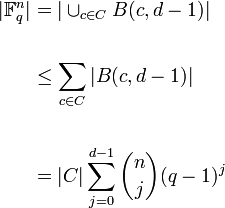Gilbert–Varshamov bound
In coding theory, the Gilbert–Varshamov bound (due to Edgar Gilbert[1] and independently Rom Varshamov[2]) is a limit on the parameters of a (not necessarily linear) code. It is occasionally known as the Gilbert–Shannon–Varshamov bound (or the GSV bound), but the name "Gilbert–Varshamov bound" is by far the most popular. Varshamov proved this bound by using the probabilistic method for linear code. For more about that proof, see: GV-linear-code.
Statement of the bound
Let
denote the maximum possible size of a q-ary code  with length n and minimum Hamming weight d (a q-ary code is a code over the field
with length n and minimum Hamming weight d (a q-ary code is a code over the field  of q elements).
of q elements).
Then:
Proof
Let  be a code of length
be a code of length  and minimum Hamming distance
and minimum Hamming distance  having maximal size:
having maximal size:
Then for all  , there exists at least one codeword
, there exists at least one codeword  such that the Hamming distance
such that the Hamming distance  between
between  and
and  satisfies
satisfies
since otherwise we could add x to the code whilst maintaining the code's minimum Hamming distance d – a contradiction on the maximality of  .
.
Hence the whole of  is contained in the union of all balls of radius d − 1 having their centre at some
is contained in the union of all balls of radius d − 1 having their centre at some  :
:
Now each ball has size
since we may allow (or choose) up to  of the
of the  components of a codeword to deviate (from the value of the corresponding component of the ball's centre) to one of
components of a codeword to deviate (from the value of the corresponding component of the ball's centre) to one of  possible other values (recall: the code is q-ary: it takes values in
possible other values (recall: the code is q-ary: it takes values in  ). Hence we deduce
). Hence we deduce
That is:
(using the fact:  ).
).
An improvement in the prime power case
For q a prime power, one can improve the bound to  where k is the greatest integer for which
where k is the greatest integer for which
See also
- Singleton bound
- Hamming bound
- Johnson bound
- Plotkin bound
- Griesmer bound
- Grey–Rankin bound
- Gilbert–Varshamov bound for linear code
- Elias-Bassalygo bound
References
- ↑ Gilbert, E. N. (1952), "A comparison of signalling alphabets", Bell System Technical Journal 31: 504–522, doi:10.1002/j.1538-7305.1952.tb01393.x.
- ↑ Varshamov, R. R. (1957), "Estimate of the number of signals in error correcting codes", Dokl. Acad. Nauk SSSR 117: 739–741.








